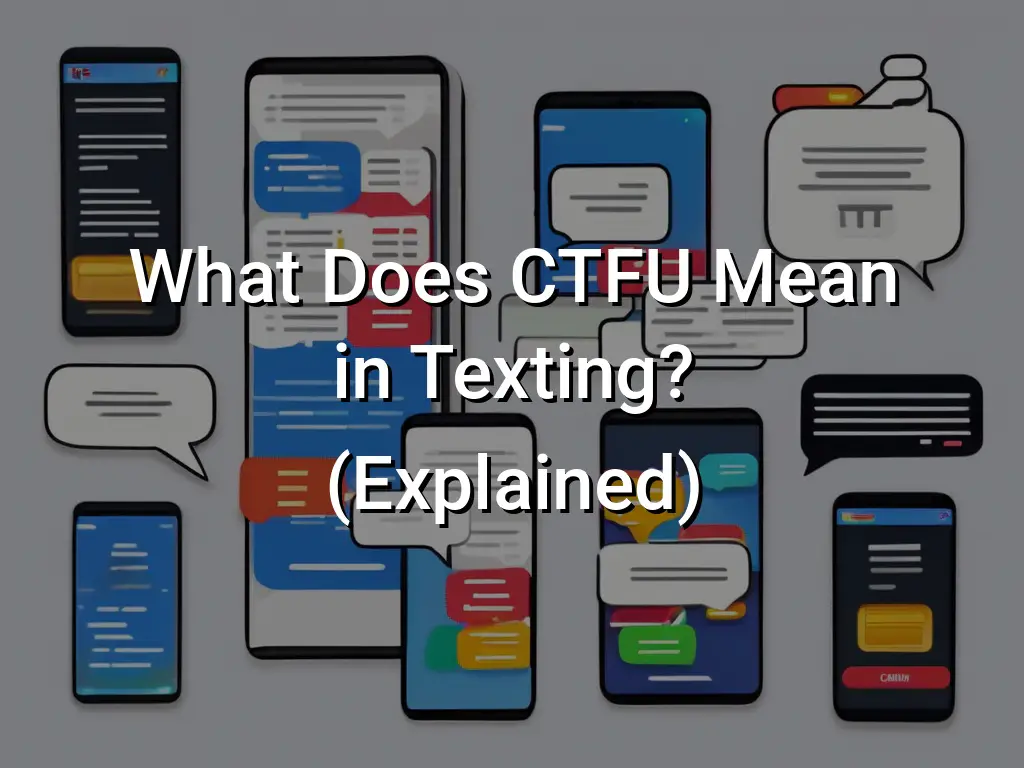What Does CTFU Mean in Texting? (Explained)

Laughing is a universal language, and in the world of digital communication, we often use abbreviations and initialisms to express our amusement. One such abbreviation is CTFU, which stands for “crack(ing) the f*ck up.” This slang term is used to indicate intense laughter and add emphasis to a funny situation.
CTFU is often written in all capital letters to convey the level of laughter and tone of the conversation. Whether you’re new to texting lingo or curious about the origins of this abbreviation, this article will provide you with a clear understanding of what CTFU means and how it is used in the world of texting.
What Does CTFU Stand For in Texting?
In the world of digital communication, abbreviations and slang terms are commonly used to convey emotions and reactions quickly. One such abbreviation is CTFU, which stands for “crack(ing) the f*ck up.” It is often used to express laughter and mark the tone of a conversation.
When someone uses CTFU in a text or online conversation, it signifies that they find something extremely funny. It is an informal way of expressing amusement and laughter. This acronym is sometimes written in all capital letters, emphasizing the intensity of the laughter or the speaker’s excitement.
CTFU has become increasingly popular in digital communication, especially in social media platforms and messaging apps. It allows people to show their emotions and convey their sense of humor quickly and concisely. Whether it’s a funny meme, a hilarious joke, or a humorous situation, CTFU adds a touch of laughter and lightness to the conversation.
So, the next time you come across CTFU in a text or chat, you’ll know that the person is cracking up with laughter and thoroughly enjoying the humorous content being shared.
Origin and Evolution of CTFU
CTFU is an acronym that has evolved from LOL (laugh out loud) and LMAO (laughing my ass off), both of which were popularized in online forums and chat rooms. As digital communication became more prevalent, people began to use these initialisms to express laughter and mark tone in their conversations.
While LOL and LMAO are still commonly used, CTFU has emerged as another slang initialism for expressing laughter. It stands for “crack(ing) the f*ck up,” and is often written in all capital letters to emphasize the intensity of the laughter.
In the fast-paced nature of digital communication, where conveying tone and emotions can be challenging, initialisms like CTFU provide a quick and efficient way to express amusement and humor. They have become a part of modern internet slang, serving as shorthand for laughter in online conversations and social media interactions.
Variations and Alternatives to CTFU
While CTFU is a commonly used slang initialism to express laughter and tone in digital communication, there are several variations and alternatives that can be used interchangeably. Here are a few examples:
- LMAO: Short for “laughing my ass off,” LMAO is another popular initialism used to indicate laughter or amusement. It is often used in response to something funny or humorous.
- ROFL: An abbreviation for “rolling on the floor laughing,” ROFL is used to express extreme laughter or amusement. It implies that something is so funny that it would make the person roll on the floor in laughter.
- LOL: One of the most well-known initialisms, LOL stands for “laugh out loud.” It is used to indicate laughter or amusement and is often used in casual conversations or online interactions.
- Haha: While not an initialism, “haha” is a common alternative to express laughter in text conversations. It is often used to convey a lighter or more casual tone.
- Hehe: Similar to “haha,” “hehe” is another alternative for expressing laughter. It is often used to convey a sense of amusement or playfulness.
These variations and alternatives can be used depending on personal preference or the tone of the conversation. They all serve the same purpose of expressing laughter and adding a lighthearted tone to digital communication.
How to Use CTFU in Texting
In Text Conversations:
CTFU can be used in texting to express amusement or to convey that something is funny. Here are some examples of how to use CTFU in text conversations:
- Friend 1: Did you see that hilarious meme? CTFU
- Friend 2: Yes! It had me cracking up too!
In Social Media Comments:
CTFU can also be used in social media comments to show laughter or amusement. Here is an example of how CTFU can be used in a comment on a funny post:
User 1: This video had me in tears! CTFU
In Digital Communication Channels:
CTFU is commonly used in various digital communication channels, such as online forums and chat rooms, to express laughter or amusement. Here is an example of how CTFU can be used in an online conversation:
User 1: That joke was hilarious! CTFU
User 2: I’m glad it made you laugh!
Remember to use CTFU sparingly and consider the context and audience before using it in digital communication.
Conclusion
CTFU, an initialism most commonly standing for “crack(ing) the f*ck up,” is a slang term used in digital communication to express laughter and mark tone. It is often written in all capital letters and is a popular way to show amusement or find something extremely funny.
While variations like LOL, LMAO, and ROFL are also used interchangeably to express laughter, CTFU has gained popularity in online forums and chat rooms. By using these slang initialisms, individuals can add humor and convey their emotions more effectively in digital conversations.
So the next time you come across CTFU in texting or online conversations, remember that it’s a fun way to show your amusement and share a good laugh with others.